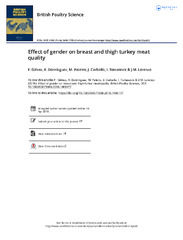Prikaz osnovnih podataka o dokumentu
Effect of gender on breast and thigh turkey meat quality
| dc.creator | Gálvez, F. | |
| dc.creator | Domínguez, R. | |
| dc.creator | Pateiro, M. | |
| dc.creator | Carballo, J. | |
| dc.creator | Tomašević, I. | |
| dc.creator | Lorenzo, J. M. | |
| dc.date.accessioned | 2022-04-20T14:28:22Z | |
| dc.date.available | 2019-05-30 | |
| dc.date.issued | 2018 | |
| dc.identifier.issn | 0007-1668 | |
| dc.identifier.uri | http://aspace.agrif.bg.ac.rs/handle/123456789/6063 | |
| dc.description.abstract | 1. The influence of gender on chemical composition, physicochemical parameters, fatty acid profile, amino acid and mineral composition of turkey breast and thigh meat was studied in order to assess nutrient requirements. 2. Chemical composition showed that only intramuscular fat in breast meat was significantly affected by gender (P<0.05). The results showed a higher percentage of intramuscular fat in male samples, almost double the amount found in females (0.73% vs. 0.38%). 3.For meat colour parameters, only a* showed different results between sexes, with male samples (breast: P<0.01; thigh: P<0.001) having the highest values. 4. Fatty acid profiles showed that medium chain unsaturated fatty acids were the most abundant. The significant differences (P<0.05) found in both breast and thigh muscle could be linked to a difference in metabolism between males and females. Accepted for publication 5 March 2018 2 5.There were higher levels of C16:1n7 in female s (breast: P<0.001; tight: P<0.01) compared with male muscle sample (5.05 vs. 2.67 g/100 g in breast and 4.95 vs. 3.27 g/100 g in thigh). Nutritional indices (n6/n3 and thrombogenic index) were more favourable in female samples demonstrating that female turkeys had better fatty acid profile than the others. 6. Turkey meat is an important source of dietary amino acids, and female samples had the highest contents both of essential and non-essential amino acids. Furthermore, gender had a numeric effect (P>0.05) on amino acid composition. 7. Mineral composition showed that Na, Zn and Fe were the minerals most affected by turkey gender. | sr |
| dc.language.iso | en | sr |
| dc.publisher | Taylor & Francis | sr |
| dc.relation | Axencia Galega de Innovación-GAIN (Regional Government) (Project NUTRIGRUPS/2015). | sr |
| dc.relation.isversionof | http://aspace.agrif.bg.ac.rs/handle/123456789/4622 | |
| dc.relation.isversionof | https://doi.org/10.1080/00071668.2018.1465177 | |
| dc.rights | embargoedAccess | sr |
| dc.rights.uri | https://creativecommons.org/licenses/by-nc/4.0/ | |
| dc.source | British Poultry Science | sr |
| dc.subject | Amino acids | sr |
| dc.subject | chemical composition | sr |
| dc.subject | fatty acids | sr |
| dc.subject | mineral composition | sr |
| dc.subject | nutritional value | sr |
| dc.subject | turkey | sr |
| dc.subject | meat quality | sr |
| dc.title | Effect of gender on breast and thigh turkey meat quality | sr |
| dc.type | article | sr |
| dc.rights.license | BY-NC | sr |
| dc.citation.issue | 4 | |
| dc.citation.rank | M22 | |
| dc.citation.volume | 59 | |
| dc.description.other | This is the peer reviewed version of the following article: Galvez, F.; Domínguez, R.; Pateiro, M.; Carballo, J.; Tomašević, I.; Lorenzo, J. M. Effect of Gender on Breast and Thigh Turkey Meat Quality. British Poultry Science 2018, 59 (4), 408–415. [https://doi.org/10.1080/00071668.2018.1465177]. | |
| dc.identifier.doi | 10.1080/00071668.2018.1465177 | |
| dc.identifier.fulltext | http://aspace.agrif.bg.ac.rs/bitstream/id/23648/Effect_of_gender_acc_2018.pdf | |
| dc.identifier.scopus | 2-s2.0-85047815788 | |
| dc.identifier.wos | 000441628800008 | |
| dc.type.version | acceptedVersion | sr |


